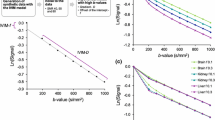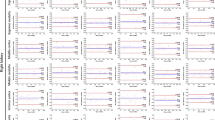Abstract
This study examined whether respiratory-controlled acquisition influences diffusion parameters obtained with intravoxel incoherent motion (IVIM) analysis using tri-exponential and bi-exponential models. Ten healthy volunteers were examined on a 3.0 T MRI system to obtain coronal diffusion-weighted images of both kidneys. The participants were scanned twice using respiratory-triggering (RT) and free-breathing (FB) acquisition to assess the repeatability of the measurements. We determined mean signal intensities in the renal cortex at each b value. Then, perfusion-related diffusion coefficient (Dp), fast-free diffusion coefficient (Df), slow-restricted diffusion coefficient (Ds), and their corresponding fractions (Fp, Ff, and Fs, respectively) were calculated using tri-exponential function. Moreover, perfusion-related diffusion coefficient (D*), the fraction (F), and perfusion-independent diffusion coefficient (D) were calculated using bi-exponential function. Normalized root-mean-square errors for the tri- and bi-exponential analyses (nRMSEtri and nRMSEbi, respectively) were determined to assess the deviation of the fitted to measured data, i.e., the fitting accuracy. Additionally, repeatability coefficients (RCs) were calculated from Bland–Altman plots to evaluate the repeatability of each diffusion parameter. These values were compared between the RT and FB groups. Dp and D* in the RT group were significantly lower than those in the FB group (P < 0.05). In addition, the RT group showed significantly lower nRMSEtri and nRMSEbi values than those in the FB group (P < 0.05). Moreover, Dp, Ds, Fs, and D* at RT showed lower RC values than those at FB. Respiratory-controlled acquisition affects perfusion-related diffusion parameters of the kidney obtained using tri-exponential and bi-exponential analyses.







Similar content being viewed by others
References
Wang H, Cheng L, Zhang X, Wang D, Guo A, Gao Y, et al. Renal cell carcinoma: diffusion-weighted MR imaging for subtype differentiation at 3.0 T. Radiology. 2010;257(1):135–43.
Bane O, Wagner M, Zhang JL, Dyvorne HA, Orton M, Rusinek H, et al. Assessment of renal function using intravoxel incoherent motion diffusion-weighted imaging and dynamic contrast-enhanced MRI. J Magn Reson Imaging. 2016;44(2):317–26.
Zhang JL, Sigmund EE, Chandarana H, Rusinek H, Chen Q, Vivier PH, et al. Variability of renal apparent diffusion coefficients: limitations of the monoexponential model for diffusion quantification. Radiology. 2010;254(3):783–92.
Le Bihan D, Breton E, Lallemand D, Aubin ML, Vignaud J, Laval-Jeantet M. Separation of diffusion and perfusion in intravoxel incoherent motion MR imaging. Radiology. 1988;168(2):497–505.
Gaing B, Sigmund EE, Huang WC, Babb JS, Parikh NS, Stoffel D, et al. Subtype differentiation of renal tumors using voxel-based histogram analysis of intravoxel incoherent motion parameters. Invest Radiol. 2015;50(3):144–52.
Hayashi T, Miyati T, Takahashi J, Fukuzawa K, Sakai H, Tano M, et al. Diffusion analysis with tri-exponential function in liver cirrhosis. J Magn Reson Imaging. 2013;38(1):148–53.
Ohno N, Miyati T, Kobayashi S, Gabata T. Modified tri-exponential analysis of intravoxel incoherent motion for brain perfusion and diffusion. J Magn Reson Imaging. 2016;43(4):818–23.
Ueda Y, Takahashi S, Ohno N, Kyotani K, Kawamitu H, Miyati T, et al. Triexponential function analysis of diffusion-weighted MRI for diagnosing prostate cancer. J Magn Reson Imaging. 2016;43(1):138–48.
van Baalen S, Leemans A, Dik P, Lilien MR, Ten Haken B, Froeling M. Intravoxel incoherent motion modeling in the kidneys: comparison of mono-, bi-, and tri-exponential fit. J Magn Reson Imaging. 2017;46(1):228–39.
Jerome NP, Orton MR, d’Arcy JA, Collins DJ, Koh DM, Leach MO. Comparison of free-breathing with navigator-controlled acquisition regimes in abdominal diffusion-weighted magnetic resonance images: effect on ADC and IVIM statistics. J Magn Reson Imaging. 2014;39(1):235–40.
Moerland MA, van den Bergh AC, Bhagwandien R, Janssen WM, Bakker CJ, Lagendijk JJ, et al. The influence of respiration induced motion of the kidneys on the accuracy of radiotherapy treatment planning, a magnetic resonance imaging study. Radiother Oncol. 1994;30(2):150–4.
Meeus EM, Novak J, Withey SB, Zarinabad N, Dehghani H, Peet AC. Evaluation of intravoxel incoherent motion fitting methods in low-perfused tissue. J Magn Reson Imaging. 2017;45(5):1325–34.
Kataoka M, Kido A, Yamamoto A, Nakamoto Y, Koyama T, Isoda H, et al. Diffusion tensor imaging of kidneys with respiratory triggering: optimization of parameters to demonstrate anisotropic structures on fraction anisotropy maps. J Magn Reson Imaging. 2009;29(3):736–44.
Notohamiprodjo M, Dietrich O, Horger W, Horng A, Helck AD, Herrmann KA, et al. Diffusion tensor imaging (DTI) of the kidney at 3 tesla-feasibility, protocol evaluation and comparison to 1.5 Tesla. Invest Radiol. 2010;45(5):245–54.
Tofts PS, Jackson JS, Tozer DJ, Cercignani M, Keir G, MacManus DG, et al. Imaging cadavers: cold FLAIR and noninvasive brain thermometry using CSF diffusion. Magn Reson Med. 2008;59(1):190–5.
Yeung DK, Wong SY, Griffith JF, Lau EM. Bone marrow diffusion in osteoporosis: evaluation with quantitative MR diffusion imaging. J Magn Reson Imaging. 2004;19(2):222–8.
Luciani A, Vignaud A, Cavet M, Nhieu JT, Mallat A, Ruel L, et al. Liver cirrhosis: intravoxel incoherent motion MR imaging–pilot study. Radiology. 2008;249(3):891–9.
Lv J, Huang W, Zhang J, Wang X. Performance of U-net based pyramidal lucas-kanade registration on free-breathing multi-b-value diffusion MRI of the kidney. Br J Radiol. 2018;91(1086):20170813.
Mao W, Zhou J, Zeng M, Ding Y, Qu L, Chen C, et al. Intravoxel incoherent motion diffusion-weighted imaging for the assessment of renal fibrosis of chronic kidney disease: a preliminary study. Magn Reson Imaging. 2018;47:118–24.
Alpert NM, Rabito CA, Correia DJ, Babich JW, Littman BH, Tompkins RG, et al. Mapping of local renal blood flow with PET and H(2)(15)O. J Nucl Med. 2002;43(4):470–5.
Wittsack HJ, Lanzman RS, Quentin M, Kuhlemann J, Klasen J, Pentang G, et al. Temporally resolved electrocardiogram-triggered diffusion-weighted imaging of the human kidney: correlation between intravoxel incoherent motion parameters and renal blood flow at different time points of the cardiac cycle. Invest Radiol. 2012;47(4):226–30.
Walker-Samuel S, Orton M, McPhail LD, Robinson SP. Robust estimation of the apparent diffusion coefficient (ADC) in heterogeneous solid tumors. Magn Reson Med. 2009;62(2):420–9.
Kartalis N, Loizou L, Edsborg N, Segersvard R, Albiin N. Optimising diffusion-weighted MR imaging for demonstrating pancreatic cancer: a comparison of respiratory-triggered, free-breathing and breath-hold techniques. Eur Radiol. 2012;22(10):2186–92.
Funding
No funding was received to assist with the preparation of this manuscript.
Author information
Authors and Affiliations
Contributions
YM: conceptualization, data curation, formal analysis, investigation, methodology, validation, visualization, and writing—original draft. NO: conceptualization, data curation, formal analysis, investigation, methodology, software, validation, and writing—review & editing. TM: supervision and writing—review & editing. NH: supervision. YM: supervision. SK: supervision. TG: supervision.
Corresponding author
Ethics declarations
Conflict of interest
This study was presented as a digital poster at the International Society of Magnetic Resonance in Medicine (ISMRM) meeting on June 15–21, 2018, in Paris, France and published as Proc. of the Intl. Soc. Mag. Reson. Med. 26: 4595.
Ethics approval
This study was performed in line with the principles of the Declaration of Helsinki. Approval was granted by the Ethics Committee of Kanazawa University (No. 848–1).
Informed consent
Informed consent was obtained from all individual participants included in the study. Participants also signed informed consent regarding publishing their data and photographs.
Additional information
Publisher's Note
Springer Nature remains neutral with regard to jurisdictional claims in published maps and institutional affiliations.
About this article
Cite this article
Makino, Y., Ohno, N., Miyati, T. et al. Tri- and bi-exponential diffusion analyses of the kidney: effect of respiratory-controlled acquisition on diffusion parameters. Radiol Phys Technol 16, 478–487 (2023). https://doi.org/10.1007/s12194-023-00734-1
Received:
Revised:
Accepted:
Published:
Issue Date:
DOI: https://doi.org/10.1007/s12194-023-00734-1




